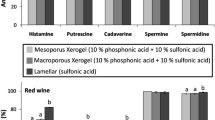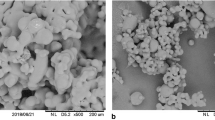Abstract
A METHOD for the estimation of sulphydryl groups in hair and other insoluble proteins by means of the specific sulphydryl reagent, 1-(4-chloromercuriphenylazo)-naphthol-2, has recently been reported by Scott and Flesch1. In this method, the hair is pulverized, treated with water at 100° or an aqueous solution of a swelling agent at 40° and shaken with a solution of the reagent in amyl acetate, the decrease in concentration of the reagent in the amyl acetate layer being measured colorimetrically.
This is a preview of subscription content, access via your institution
Access options
Subscribe to this journal
Receive 51 print issues and online access
$199.00 per year
only $3.90 per issue
Buy this article
- Purchase on Springer Link
- Instant access to full article PDF
Prices may be subject to local taxes which are calculated during checkout
Similar content being viewed by others
References
Science, 119, 70 (1954).
Flesch and Kun, Proc. Soc. Exp. Biol. Med., 74, 249 (1950).
Private communication from Dr. P. Flesch.
Bull. Inst. Text. France, 30, 255 (1952).
Marston, “Fibrous Proteins”, 211 (Society of Dyers and Colourists, Bradford, 1946).
Palmer, R. C., J. Agric. Sci., 39, 265 (1949).
Zahn, Kolloid-Z., 113, 157 (1949).
Author information
Authors and Affiliations
Rights and permissions
About this article
Cite this article
BURLEY, R. Sulphydryl Groups in Wool. Nature 174, 1019–1020 (1954). https://doi.org/10.1038/1741019a0
Issue Date:
DOI: https://doi.org/10.1038/1741019a0
This article is cited by
-
Über die chemische Modifizierung von Keratinen bei der Methylierung von Aminosäureseitengruppen
Colloid and Polymer Science (1974)
-
Experiments on Wool from Copper-Deficient Sheep
Nature (1959)
-
Role of Sulphydryl Groups in the Long-range Elasticity of Wool
Nature (1955)
Comments
By submitting a comment you agree to abide by our Terms and Community Guidelines. If you find something abusive or that does not comply with our terms or guidelines please flag it as inappropriate.



